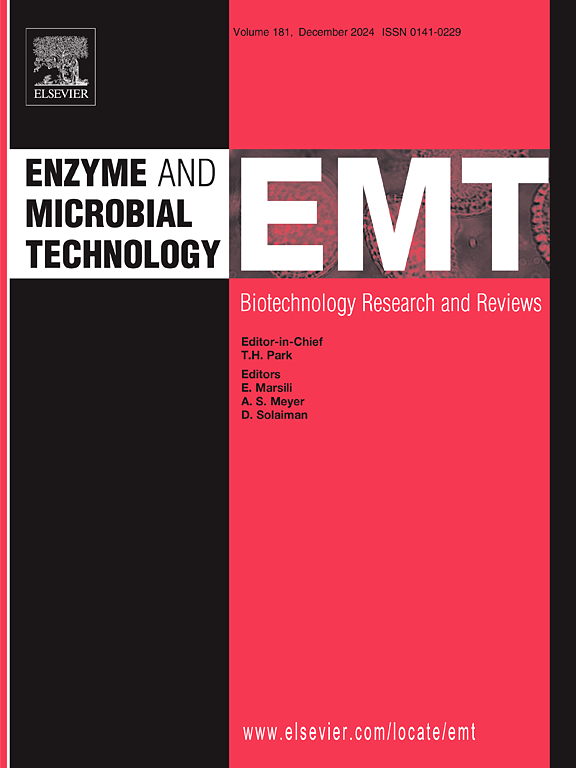Enhanced lipid accumulation in microalgae Scenedesmus sp. under nitrogen limitation
IF 3.4
3区 生物学
Q2 BIOTECHNOLOGY & APPLIED MICROBIOLOGY
引用次数: 0
Abstract
Microalgae-based biofuel production is cost-effective only in a biorefinery, where valuable co-products offset high costs. Fatty acids produced by photosynthetic microalgae can serve as raw materials for bioenergy and pharmaceuticals. This study aims to understand the metabolic imprints of Scenedesmus sp. CABeR52, to decipher the physiological mechanisms behind lipid accumulation under nitrogen deprivation. Metabolomics profiles were generated using gas chromatography-mass spectrometry (GC–MS) of Scenedesmus sp. CABeR52 subjected to nutrient deprivation. Our initial data sets indicate that deprived cells have an increased accumulation of lipids (278.31 mg.g−1 dcw), 2.0 times higher than the control. The metabolomic profiling unveils a metabolic reprogramming, highlighting the upregulation of key metabolites involved in fatty acid biosynthesis, such as citric acid, succinic acid, and 2-ketoglutaric acid. The accumulation of trehalose, a stress-responsive metabolite, further underscores the microalga's adaptability. Interestingly, we found that a new fatty acid, nervonic acid, was identified in the complex, which has a significant role in brain development. These findings provide valuable insights into the metabolic pathways governing lipid accumulation in Scenedesmus sp., paving the way for its exploitation as a sustainable biofuel feedstock.
氮限制条件下微藻类 Scenedesmus sp.
只有在生物精炼厂中,基于微藻的生物燃料生产才具有成本效益,因为在生物精炼厂中,有价值的副产品可以抵消高昂的成本。光合微藻产生的脂肪酸可以作为生物能源和制药的原料。本研究旨在了解 Scenedesmus sp. CABeR52 的代谢印记,以破译缺氮条件下脂质积累背后的生理机制。研究人员利用气相色谱-质谱联用技术(GC-MS)生成了营养匮乏条件下的景天科植物 CABeR52 的代谢组学图谱。我们的初步数据集表明,缺乏营养的细胞中脂类积累增加(278.31 mg.g-1 dcw),是对照组的 2.0 倍。代谢组分析揭示了一种代谢重编程,突出显示了参与脂肪酸生物合成的关键代谢物的上调,如柠檬酸、琥珀酸和 2-酮戊二酸。应激反应代谢物三卤糖的积累进一步突出了微藻的适应性。有趣的是,我们发现在该复合体中发现了一种新的脂肪酸--神经酸,它在大脑发育中起着重要作用。这些发现为我们深入了解管理景天藻脂质积累的代谢途径提供了宝贵的信息,为将其开发为可持续生物燃料原料铺平了道路。
本文章由计算机程序翻译,如有差异,请以英文原文为准。
求助全文
约1分钟内获得全文
求助全文
来源期刊

Enzyme and Microbial Technology
生物-生物工程与应用微生物
CiteScore
7.60
自引率
5.90%
发文量
142
审稿时长
38 days
期刊介绍:
Enzyme and Microbial Technology is an international, peer-reviewed journal publishing original research and reviews, of biotechnological significance and novelty, on basic and applied aspects of the science and technology of processes involving the use of enzymes, micro-organisms, animal cells and plant cells.
We especially encourage submissions on:
Biocatalysis and the use of Directed Evolution in Synthetic Biology and Biotechnology
Biotechnological Production of New Bioactive Molecules, Biomaterials, Biopharmaceuticals, and Biofuels
New Imaging Techniques and Biosensors, especially as applicable to Healthcare and Systems Biology
New Biotechnological Approaches in Genomics, Proteomics and Metabolomics
Metabolic Engineering, Biomolecular Engineering and Nanobiotechnology
Manuscripts which report isolation, purification, immobilization or utilization of organisms or enzymes which are already well-described in the literature are not suitable for publication in EMT, unless their primary purpose is to report significant new findings or approaches which are of broad biotechnological importance. Similarly, manuscripts which report optimization studies on well-established processes are inappropriate. EMT does not accept papers dealing with mathematical modeling unless they report significant, new experimental data.
 求助内容:
求助内容: 应助结果提醒方式:
应助结果提醒方式:


